At the beginning of 2015 whilst planning the year's activities, Paul, G3SXE, suggested that we have a go at a major international HF contest. Whilst the group have experience of competing in smaller short duration contests such as the RSGB backpackers', VHF activity and 21/28MHz contests, big HF contests are a completely different proposition...
The decision was made to focus on CQWW SSB in October as it is one of the biggest HF contests in the world and being in October allowed the whole summer to develop the station and antennas. The multi-one category was chosen so that several operators could get a taste of contesting.

It soon became apparent that we simply did not have the manpower to run a station for the full 48 hours of the contest. With most members still having to work for a living we could not set up on Friday, operate for two whole days and then clear up on Monday. The decision was made to operate for just the middle 24 hours of the contest, from midday Saturday until midday Sunday, allowing setup on Saturday morning and tear down on Sunday afternoon with everyone home in time for tea!
During the year a number of planning and preparation tasks were completed. The group had acquired a 2 element beam for 10, 15 and 20m which needed some TLC. A couple of working parties soon had it stripped, cleaned and re-assembled in perfect working order. A day at the field sorted out getting it into the sky and proved that it worked on the air. We also checked that the radio (Kenwood TS570D) and linear amplifier (SRW Kilowatt – Loudenboomer) played nicely together. Mark, M0TVV, and David, M0HVD, worked on getting the N1MM+ logging software running and interfaced to the transceiver. A nest of wire dipoles was constructed for 40, 80 and 160m.
Come the weekend of the contest the weather was forecast to be mostly dry although rather cold at night. With two caravans and a large awning providing accommodation, two large trees to support the dipoles at about 45' (14m), and a 30' (10m) pole for the 2 element beam, everything was ready to go just before midday local time.
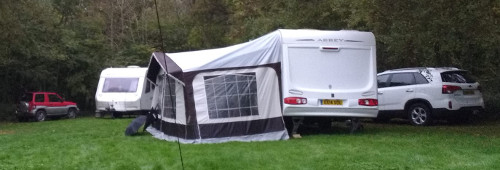
David did a fabulous job of catering for everyone from his caravan with plenty of seating in the awning. Martin, G7RQD, provided home-made soup for lunch which was taken in shifts as some were keen to get on the air as soon as possible!

Fortunately the 10m band was open and several contacts were made around Europe and some DX contacts to the Middle East, India and South America within the first hour. In the second hour the QSO rate dropped, but contacts included the Carribean, Asia, north Africa and the USA before the decision was made to move to 15m.
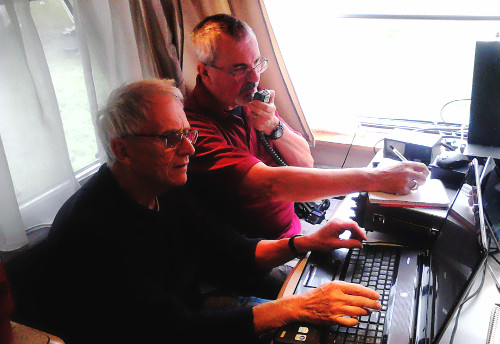
The "Armstrong" rotator worked well with 70cm QRP communications between the operators in the caravan and the antenna aimer out in the field. It did rain for a while and Mark was to be seen sitting under an umbrella turning the antenna to and fro as demanded by the radio operator!
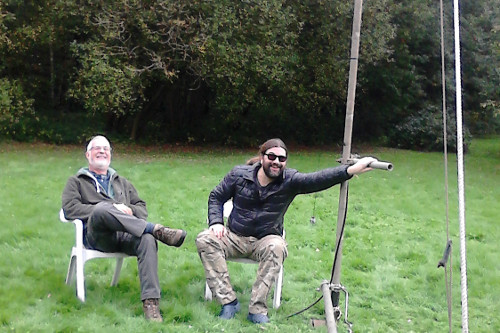
Changing to 15m boosted the QSO rate and provided many more contacts with the USA, from Massachusetts to California, within the first hour. The contacts kept coming and another 5 hours were spent on 15m notching up contacts from Europe, Africa (including our only contact with South Africa), South America, the Carribean and North America.
By 8pm it was already dark and a move was made to 20m. Transatlantic signals were excellent and the vast majority of contacts were with the USA, Canada and the Carribean. Very few European contacts were made. We stayed on 20m until about 11:30pm, probably longer than we should have as the QSO rate dropped – but we were having fun working several different US states. It was also getting very cold standing outside to operate the rotator for the beam.
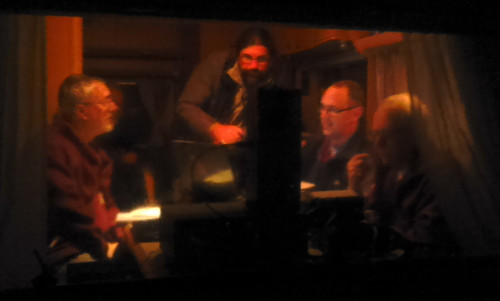
Somewhere during the course of the evening Martin's chilli appeared and a few beers may also have been consumed. Once again David ensured that everyone was fed and watered. Peter, M0PCR, provided apple crumble for dessert and, as it turned out, his first ever experience of making custard. The whole dining experience exceeded everyone's expectations for a contest, giving rise to the suggestion for a new phonetic representation of the group's callsign –
Mike Zero Really Excellent Grub!

Around 11pm several people opted for a comfortable bed at home, leaving Paul, G3SXE, Mark, and Gary, G0XAN to work the night shift with chief cook David opting to sleep in his caravan with the intention of getting up in the small hours to do a turn on the radio.
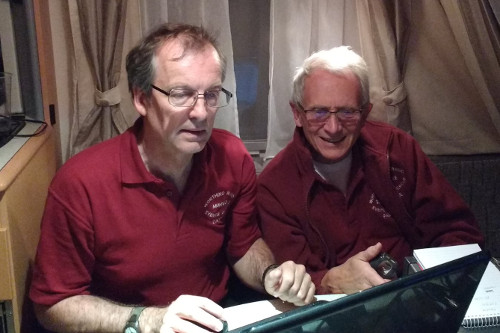
Moving to 40m boosted the QSO rate again and provided contacts with Qatar and Kazakhstan in the first half hour in addition to the expected Europeans. In the following hour and a half more DX went into the log from the Azores and Cape Verde toVenezuela and the USA.
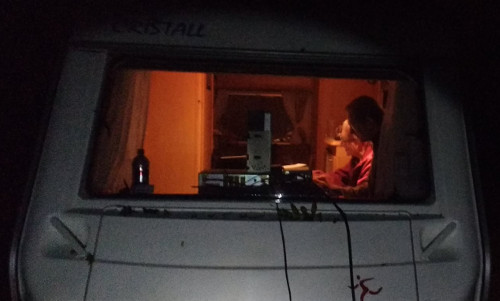
At 1:30am we moved to 80m and as expected made contacts with many European countries. Contacts with Morocco and the Canary Islands provided some moderate DX from our modest wire antenna.
At 2am it was suddenly 1am again! We had a weird sense of deja-vu as the clock on the PC automatically changed from BST to GMT. Fortunately the logging program knows to use UTC and ignores the local time display! This bonus hour meant that we got to operate for 25 hours instead of 24, but we lost our "extra hour in bed".
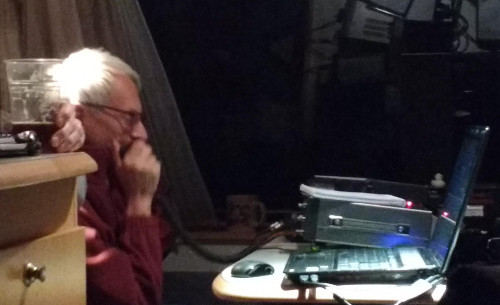
At the second 2am (!) we moved to top band. Having only contacted stations in Europe and north Africa on 80m Paul confidently predicted that we "won't get Stateside on Top Band" given our relatively low wire dipole with slightly drooping ends...
Top Band started well for us. Although most contacts were in Europe as we expected, we made some interesting and "rare" (outside of contests at least) contacts – Andorra, Cueta & Melilla and the UN World Food Programme in Rome.
At 0314UTC we logged VY2ZM on 160m! OK so he's on Prince Edward Island (about as close to the UK as is possible in North America) and his huge full-sized phased vertical array of antennas was probably doing most of the work, but he heard our signal first call and we got the contact in the log! Despite the fatigue starting to set in, we were quite surprised and elated.
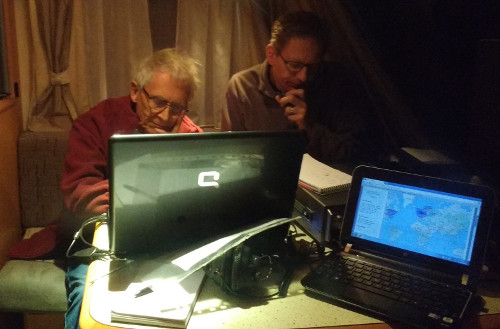
Around 4am Gary retired to his tent leaving Paul and Mark to move back up to 80m. Paul was also flagging and took a nap leaving Mark to soldier on alone. The log shows that he managed a good QSO rate and apart from the expected Europeans managed to get the USA and US Virgin Islands in the log.
Around 6am Gary decided the tent was too cold and it was better to get up and enjoy the warmth of the caravan rather than trying to sleep any longer. Paul had also awoken and David was busy preparing a light breakfast and, most importantly, coffee.
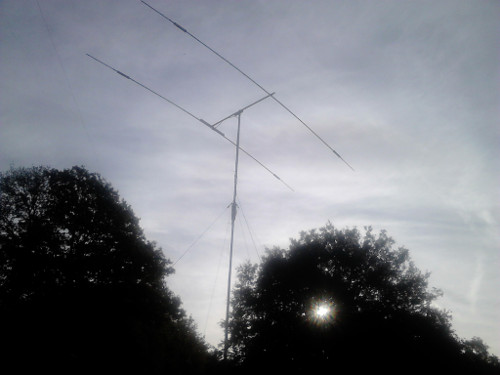
David confessed to waking up around 1am with the intention of coming to the radio caravan, but then all of a sudden it was about 5:30! Mark had manfully continued throughout the night and was relieved by the re-appearence of Paul and Gary for the move back up to 40m as the sun started to come up.
Back on 40m there was more DX to be contacted, including Brazil and Columbia, in addition to yet more Europeans. After just an hour it was time to move on up the band as contacts were drying up.
20m was skipped as 15m was open to the east. In an hour and a half contacts were made to eastern and southern Europe plus Japan, China and the Middle East. We tried the 40m diploe on 15m and it worked very well. We could hear the Japanese stations almost as well as on the beam, but it took the extra "oomph" of the beam to get our signal heard through the pile-up in Japan.
At 8:30am we tried 10m to see if we could make any contacts to Asia. We were not disappointed. The first half hour brought contacts with Thailand, Kazakhstan and Asiatic Russia. The following hour brought Tajikistan, China, Indonesia, Qatar and the UAE as well as more contacts with Asiatic Russia and eastern Europe. The next hour brought contacts from around the world; Asia, Europe, the Middle East, Africa, South America and the Carribean.
Whilst the night shift team were blinking in the daylight and struggling to keep the station running reinforcements arrived in the shape of Martin and Mike, G0JXX, who had both had the benefit of a decent night's sleep at home. Mark, Paul and Gary were pleased to let some fresh voices take over the microphone!
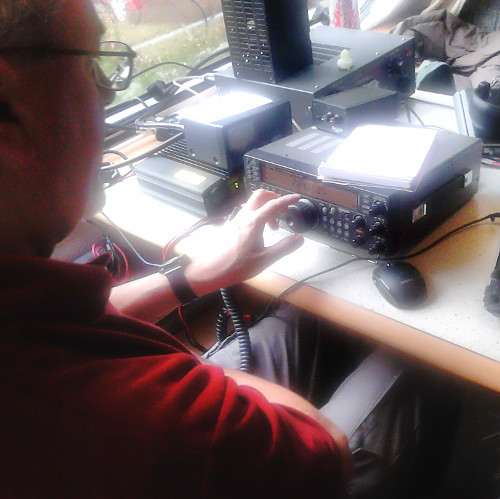
Around 11am we moved back down to 15m which was still very busy. In half an hour we picked up a few new countries in eastern Europe plus a couple of stations in Asia and a couple more in Brazil. During our last hour of operation we reached 300,000 points according to the log.
With Mike operating and Gary logging the final sprint was on. The last half hour was spent on 20m. The band was open for DX with contacts to Aruba, USA and Canada but there were also lots of European stations available. Previously we had only been on 20m when it had been dark so we had mostly contacted stations outside of Europe. With so many "new" country multipliers available Mike single-handedly added 40,000 points to the total before we called time at midday. Our last hour was our best QSO rate by almost a factor of two! Did someone give Mike too much coffee?
Meanwhile David had been busy preparing brunch for everyone. A mass of eggs, bacon and sausages disappeared remarkably quickly and then it was time to pack everything away.
By 1:30pm the site was completely clear, particularly thanks to Graham, G8ZNK, Mark and Peter who came back to the site to help with the clear-up effort.
In conclusion it was a great weekend, we made a good score for a small team and, whilst there are things to improve for next year, everything went pretty well thanks to all the hard work, planning and preparation.

Statistics
Since the most common question at any amateur radio station is, "How far have you got?" here is a list of the best DX on each band:
| Band | Callsign | Country | Distance |
| 160m | VY2ZM | Canada | 4444km (2777 miles) |
| 80m | KP2M | US Virgin Islands | 6688km (4180 miles) |
| 40m | PQ5B | Brazil | 9945km (6215 miles) |
| 20m | PX5E | Brazil | 9913km (6195 miles) |
| 15m | CB1H | Chile | 10736km (6710 miles) |
| 10m | YB1C | Indonesia | 11868km (7417 miles) |
For contesting, of course, it's all about the number of stations and multipliers contacted. Here's a band-by-band breakdown:
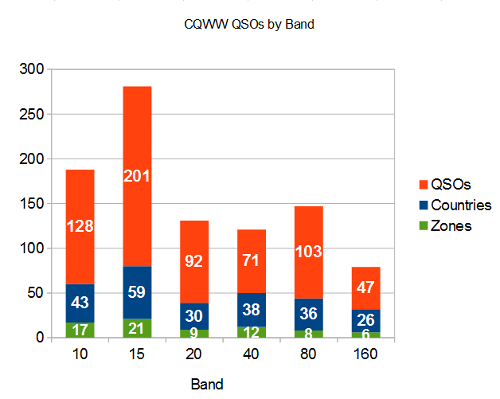
The overall totals were:
643 QSOs (509 individual stations)
89 Countries
26 Zones
In addition to contacting 89 different countries, we also contacted 27 US states from the east coast to the west coast and from the Canadian border to the Gulf of Mexico.
Our average QSO rate was just over 25 QSOs per hour, not too bad considering we were only operating in "search and pounce" mode. Interestingly we achieved over double our average run rate in the last hour of operation.
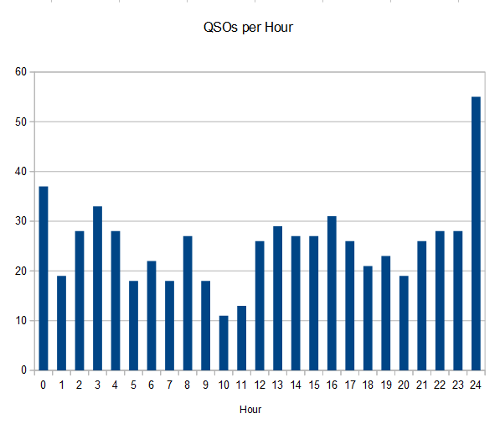
Our top three countries by number of QSOs were unsurprisingly USA, Russia and Italy, but what was surprising was that almost half the Italian contacts were apparently with stations on the island of Sicily (do Italian contest calls just look like Sicilian calls?).
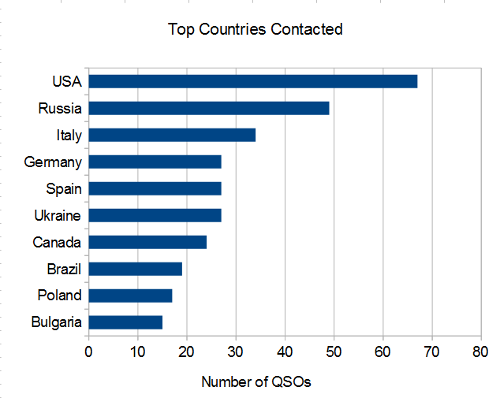
We also contacted six countries on all 6 bands: Germany, Hungary, Italy, Morocco, Spain and Ukraine. We contacted a further eight countries on 5 bands including the Canary Islands and the USA.